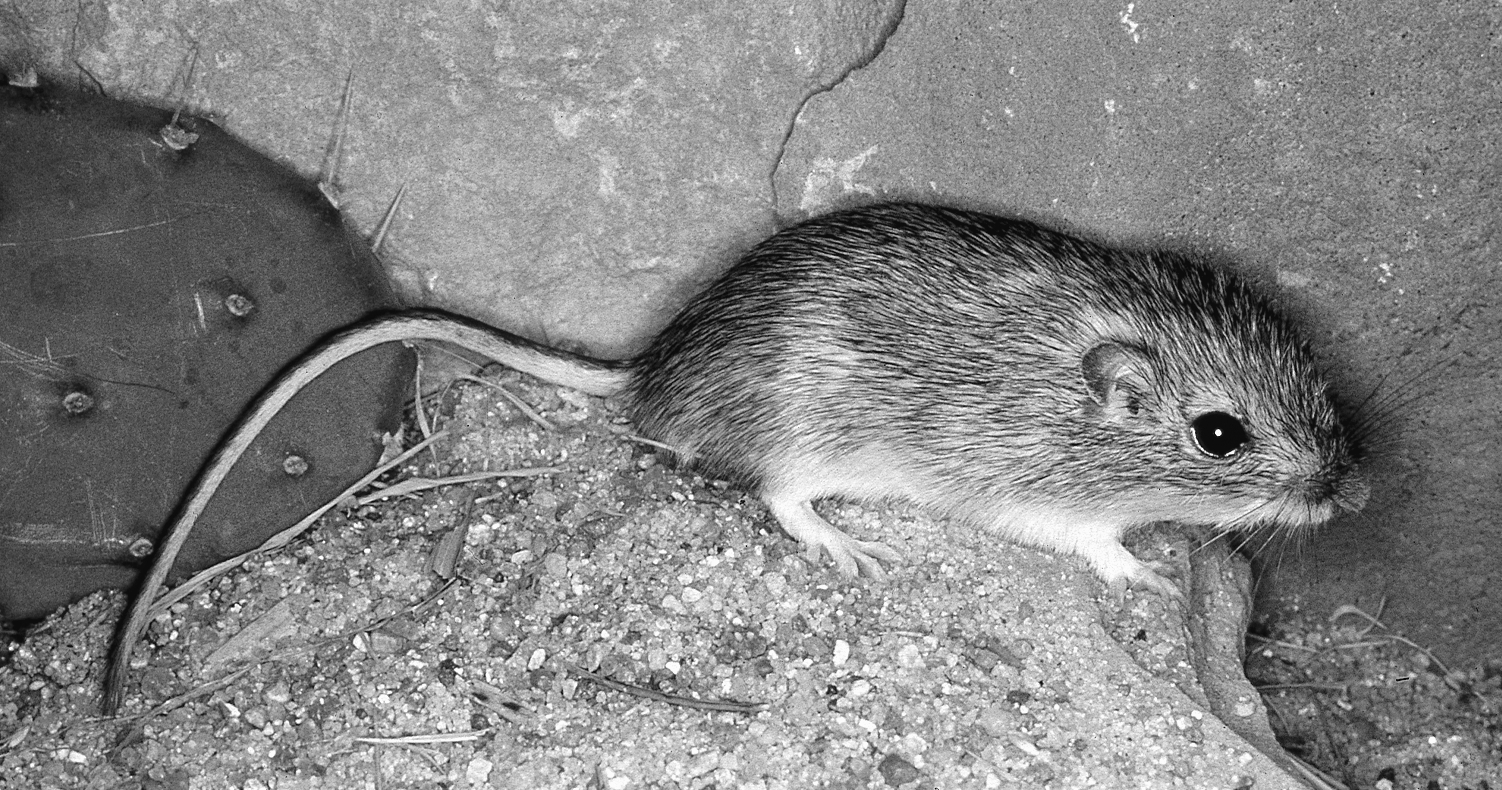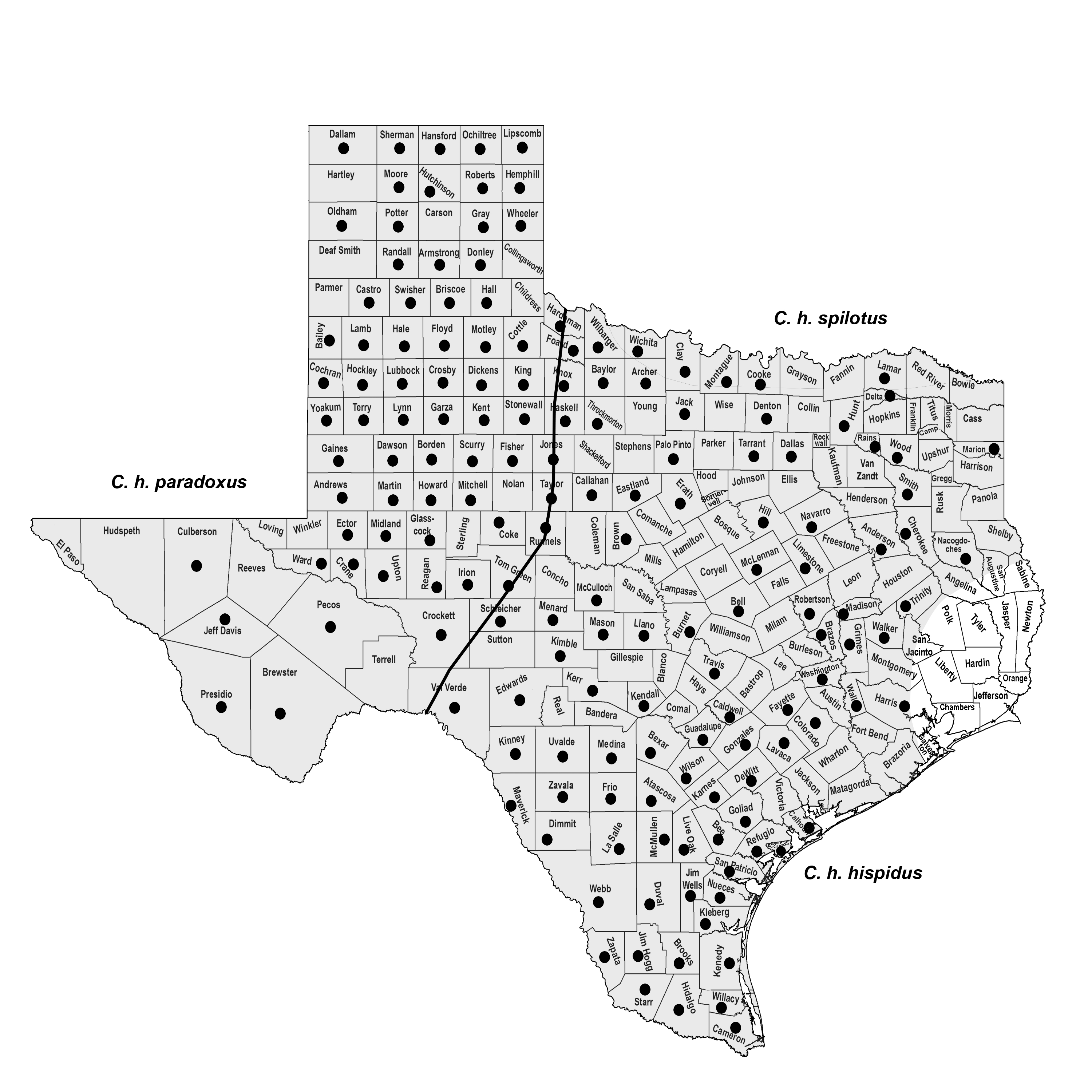HISPID POCKET MOUSE
Chaetodipus hispidus Baird 1858
Order Rodentia : Family Heteromyidae
DESCRIPTION. A medium to large pocket mouse with harsh pelage and large hind foot, the sole of which is naked to the heel; tail less than half of total length, distinctly bicolor, sparsely haired, and lacking tuft; upperparts olive buffy, lined with black; lateral line wide and clear buff; underparts white. Dental formula: I 1/1, C 0/0, Pm 1/1, M 3/3 × 2 = 20. Averages for external measurements: total length, 198 mm; tail, 93 mm; hind foot, 24 mm. Weight of adults, 30–47 g.

DISTRIBUTION. Statewide except for extreme southeastern portion of the state.

SUBSPECIES. Chaetodipus h. hispidus in the east, C. h. paradoxus in the western one-third of the state, and C. h. spilotis in a limited area of north-central Texas.
HABITS. These large pocket mice prefer a variety of dry, grassland habitats, characterized by areas of sand or other friable soil covered with scattered to moderate stands of herbaceous vegetation. The margins of brush fields and the rank growth in fencerows offer suitable cover along with highway right-of-ways. Dense stands of grasses and brush usually are avoided. These mice are not limited by soil substrate and may be found in sandy, loamy, and shallow rocky soils.
Their burrows are always dug in friable soil. They have been described as resembling 25 mm auger holes bored straight into the ground. Usually all the dirt excavated from the burrow system is piled near one opening, leaving the others inconspicuous and without mounds. The openings usually are plugged in the daytime. A burrow excavated in Brazos County had two openings, neither of which was plugged, connected by a single tunnel that descended to a depth of about 40 cm. A side branch contained food and nest chambers. Another burrow was found opening under a log, which served as a roof for the nest chamber. These pocket mice have been known to inhabit deserted burrows of Rio Grande ground squirrels in central Texas.
Their nest is composed of shredded dry grasses and weeds. In captivity, the pocket mice pile the nesting material into a loose heap and then mat it down by sleeping on top of the structure. They seem to behave likewise in the wild. They appear to be active through most of the year in the southern part of their range. They are not known to hibernate but may become torpid during periods of food shortage.
Their food consists almost entirely of vegetation, principally seeds. Seeds most often are collected from the ground, but occasionally this pocket mouse will climb vegetation in an effort to gather food. In 1937, Frank Blair found the seeds of gaillardia, cactus, evening primrose, and winecup most frequently in their caches; in addition, he lists 23 other species of plants that were utilized. In Texas, a cache of about 0.5 L of Diodia teres (poorjoe) seeds was found, and in another instance the store was entirely seeds of sandbur grass (Cenchrus). Animal matter makes up only a small part of their diet. Blair lists grasshoppers, caterpillars, and beetles.
Some reproduction occurs in Texas throughout the year given favorable conditions. Pregnant females have been taken on the Llano Estacado in May through August and November. Young animals out of the nest (about 1 month old) have been captured as early in the year as January and March and from June through October. Based on embryo counts, the litter varies from two to nine, averaging six. Nothing is known regarding the gestation period or the growth and development of the young.
In sandy-land farming areas, these mice can do considerable damage by digging up and carrying away planted seeds of cantaloupe, watermelon, peas, and small grains. In range and pasturelands, they perform a service by eating seeds of weeds, sandbur, and other undesirable plants.
POPULATION STATUS. Uncommon to common. The hispid pocket mouse occurs statewide and can be locally abundant, especially in the western regions of the state. However, it appears to be declining in the central and eastern portions of its range.
CONSERVATION STATUS. The IUCN lists the hispid pocket mouse as a species of least concern, and it does not appear on the federal or state lists of concerned species. The conservation status of C. hispidus is stable at the present time, but this is another species that could be reduced by the continued degradation of grassland habitats in Texas. Thus, its status should be assessed periodically to determine population levels.
From The Mammals of Texas, Seventh Edition by David J. Schmidly and Robert D. Bradley, copyright © 1994, 2004, 2016. Courtesy of the University of Texas Press.
Natural Science Research Laboratory
-
Address
Museum of Texas Tech University, 3301 4th street, Lubbock, TX 79409 -
Phone
806.742.2486 -
Email
nsrl.museum@ttu.edu

